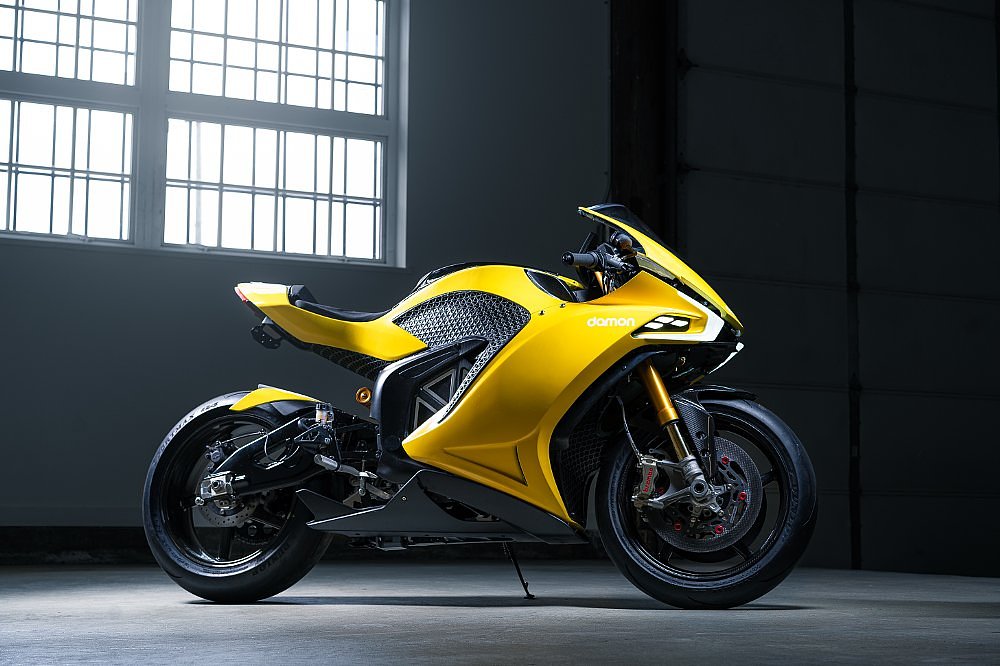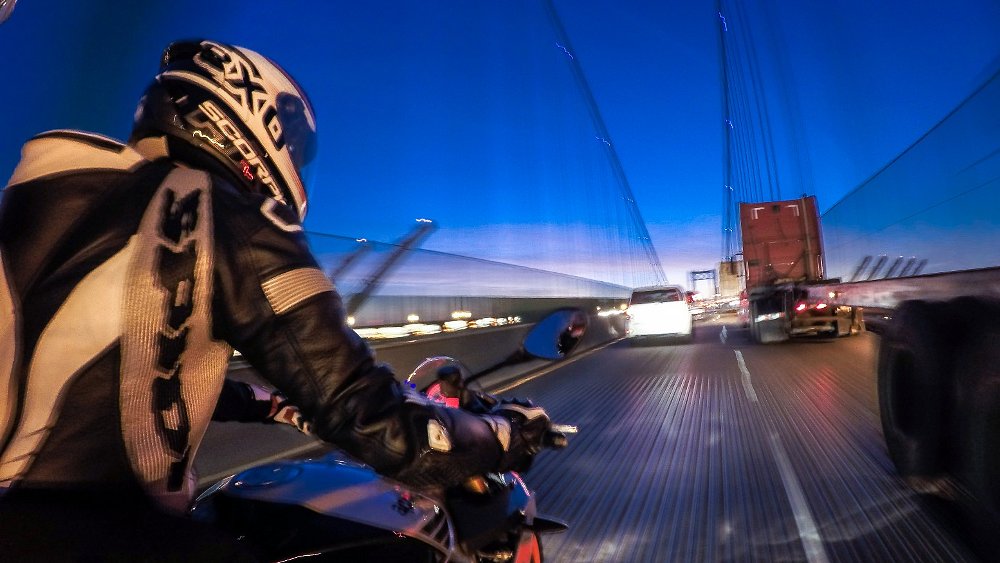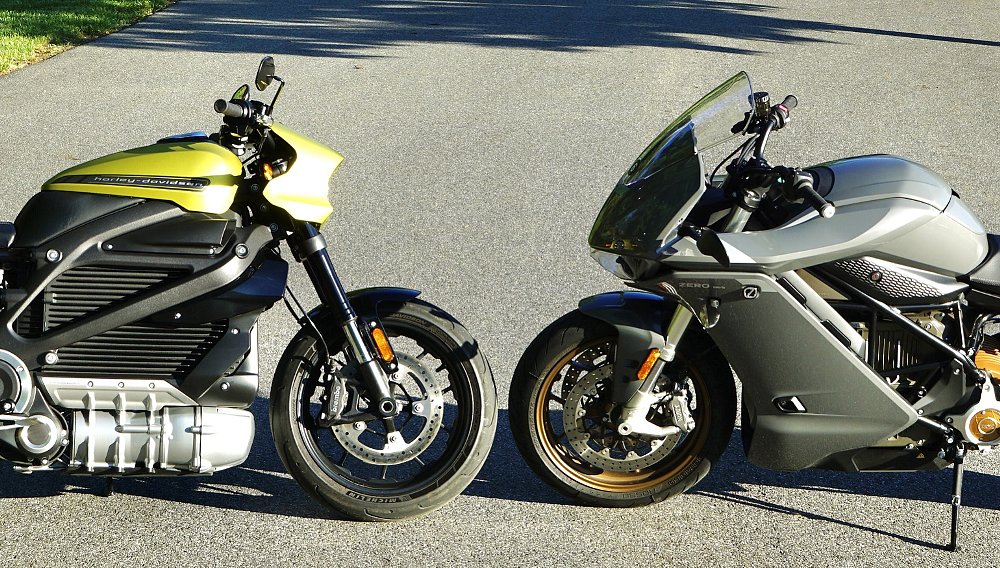Many riders are skeptical about motorcycle startups in general and electric motorcycle startups in particular. And not entirely without reason.
Companies have failed, leaving consumers abandoned. Some made performance promises that weren't fulfilled in the real world. Delivery dates get pushed back.
In that context, it's not surprising there was some mixed chatter about a video recently released by Canadian startup Damon Motorcycles that teased its forthcoming HyperFighter model — and showed footage of a Ducati Streetfighter. See the Damon teaser below and an earlier unrelated video below that.
Damon unveiled its HyperSport sport bike at CES, the annual consumer electronics show in Las Vegas, in January, 2020, and recently announced it will display the HyperFighter Colossus, a 100-unit, limited-edition version of its HyperFighter "streetfighter" motorcycle, at CES a little more than a week from now. When the teaser video came out, someone recognized the Ducati footage and that led to a discussion in the Electric Motorcycle Forum. Some said the Ducati video was no big deal but others said it suggested something fishy — or worse — was going on.
Damon co-founder and CEO Jay Giraud has been more accessible than most company executives, sometimes even responding directly to critics and skeptics and publicly offering his phone number. So I decided to ask: Given all the skepticism a company like Damon faces, why give critics ammunition by showing a Ducati Streetfighter in a Damon HyperFighter video?
"That is very unfortunate," Giraud said of the Ducati footage. He explained that it was difficult to impossible to get video of the actual HyperFighter because of the weather and the lack of a race track with charging facilities in the Vancouver area, where Damon is based. So the video producer used the royalty-free footage of the Streetfighter.
"He absolutely should not have used that video clip," Giraud said. "It does more harm than good."
The video kerfuffle aside, there's a lot of interest in — and questions about — Damon. So I pressed Giraud on where the company stands in delivering motorcycles to consumers, nearly two years after its first CES appearance with the HyperSport.
More to the story than a Ducati in a video
Interest in Damon and skepticism directed toward the company are both fed by the big promises it has made in the form of nice, round numbers: 200 mph top speed, 200 horsepower and 200-mile range for the HyperSport HS. And that's not to mention the company's Copilot 360-degree radar system intended to increase safety and its Shift feature that allows the rider to change the handlebar and footpeg positions to go from a sport-riding position to more upright ergonomics with the push of a button while riding. All for $25,000. If Damon delivers on those promises, it will have an electric motorcycle unmatched by anything else currently on the market.
But the fact is that no Damon HyperSports will be delivered to customers until late 2022, even if all goes well. So the skeptics ask why Damon is introducing the HyperFighter at CES this year when it still hasn't come close to delivering the HyperSport it introduced two years ago. As one poster at the Electric Motorcycle Forum put it, "A company that hasn't delivered anything but hype is already releasing a second model." I admit that I also wondered why we were seeing the HyperFighter before the HyperSport was out. The answer, Giraud said, has to do with proving the company's concept.
The core of Damon motorcycles is what the company calls HyperDrive, which is not just the drivetrain of batteries and motor, but also a monocoque chassis that serves as both the motorcycle's frame and the battery enclosure, instead of bolting a battery box into a more traditional motorcycle frame, which is the common approach. Damon has raised $60 million from investors and those people want to see that the company can become profitable. The way to do that is to build multiple models based on the HyperDrive core.
"If we can't prove we can build a second bike on the same platform as the first bike, then the fear is that this company is going to need $50 million every time it wants to produce a motorcycle," Giraud said. "We have to prove the platform concept is real and the HyperFighter does that."
That's why you're about to see a HyperFighter unveiled at CES. A startup has to keep both investors and potential customers happy, and sometimes they have conflicting interests.
Giraud says the potential market is five times larger for the HyperFighter, which is more similar to a powerful naked internal combustion bike (dare I mention the Streetfighter again?), than it is for a sport bike like the HyperSport. He says 85 percent of the parts are the same on both the HyperSport and the HyperFighter. The main differences are the software, the bodywork and the head stock that bolts to the front of the monocoque and holds the front suspension.
The platform concept also opens the door to future models built around the same HyperDrive core. A different swingarm and head stock combination would change wheelbase, rake and trail, for example, and be the basis for an adventure-tourer or cruiser or other style of motorcycle. But that's a "someday" thing.
"We're not going to be unveiling a third motorbike or even designing a third motorbike until we're shipping the first and second one," Giraud said. "We are totally focused on getting our orders to market first. If we can't get our customers the bikes they ordered, nothing matters."

So when does production start?
That's the other big question among those watching Damon, especially riders interested in owning one.
To get on the list to buy a HyperSport, all you have to do is make a $100 refundable deposit. The low amount, Giraud said, is the industry's response to defusing the skepticism built by other companies that asked for big deposits and later went out of business. Damon currently reports $48 million in orders, and I quizzed Giraud on the numbers behind that figure. The $48 million assumes that everyone who has put down a $100 deposit will buy a HyperSport. Clearly, that won't happen. But, as Giraud notes as a counterpoint, the order book is growing steadily. Current deposits being canceled are about 12 percent the size of new orders coming in, he said. So the order book will be larger by the time production begins but the conversion rate will certainly not be 100 percent. Actual sales remain to be seen.
And when will production begin? That's the real question.
Serial production of HyperSports won't begin until a new 110,000-square-foot manufacturing facility in Surrey, British Columbia, is complete. Giraud said the concrete foundation was poured in recent weeks. Yes, that's a delay. Record rainfall and devastating floods in the region in November prevented the foundation from being poured earlier. The completion date for the building is now projected for October 2022, and serial production can begin only after the plant is ready.
Meanwhile, the $40,000 limited-edition HyperSport Premier models will be built at a smaller existing production facility, but that also won't happen until October.
HyperDrive and hype
Giraud recognizes the basis for skepticism but pushes back against it. The Damon performance claims are not fiction, he says.
"You have to understand the engineering to understand why it's possible, and why it's real," he said. Much of that engineering can be traced back to intellectual property and personnel from the defunct Mission Motors and Alta. HyperDrive does look like nothing else on the market right now, with its six-phase motor that spins at 18,000 rpm and uses oil cooling internally and has external, targeted liquid cooling for the batteries. With its monocoque frame serving as a battery enclosure, the HyperDrive unit looks like batteries molded into the shape of the core of a motorcycle instead of a box of batteries bolted into a motorcycle frame.
It all sounds good.
But until production begins and people who put down deposits can start doing the test rides Damon has promised, the skepticism won't go away. And it appears we have almost a year to wait.









